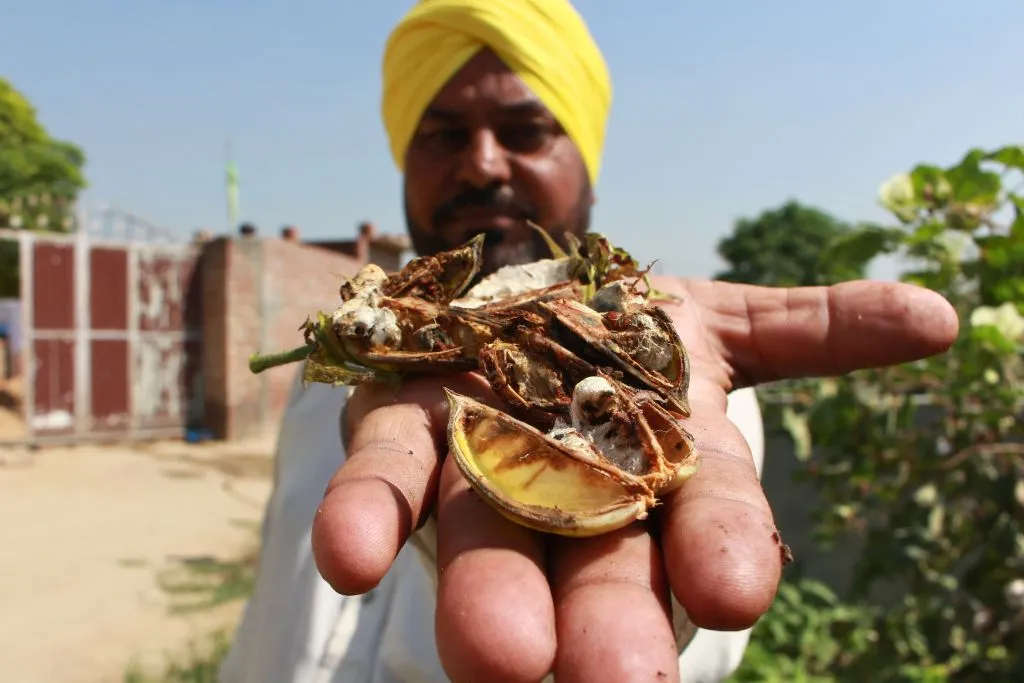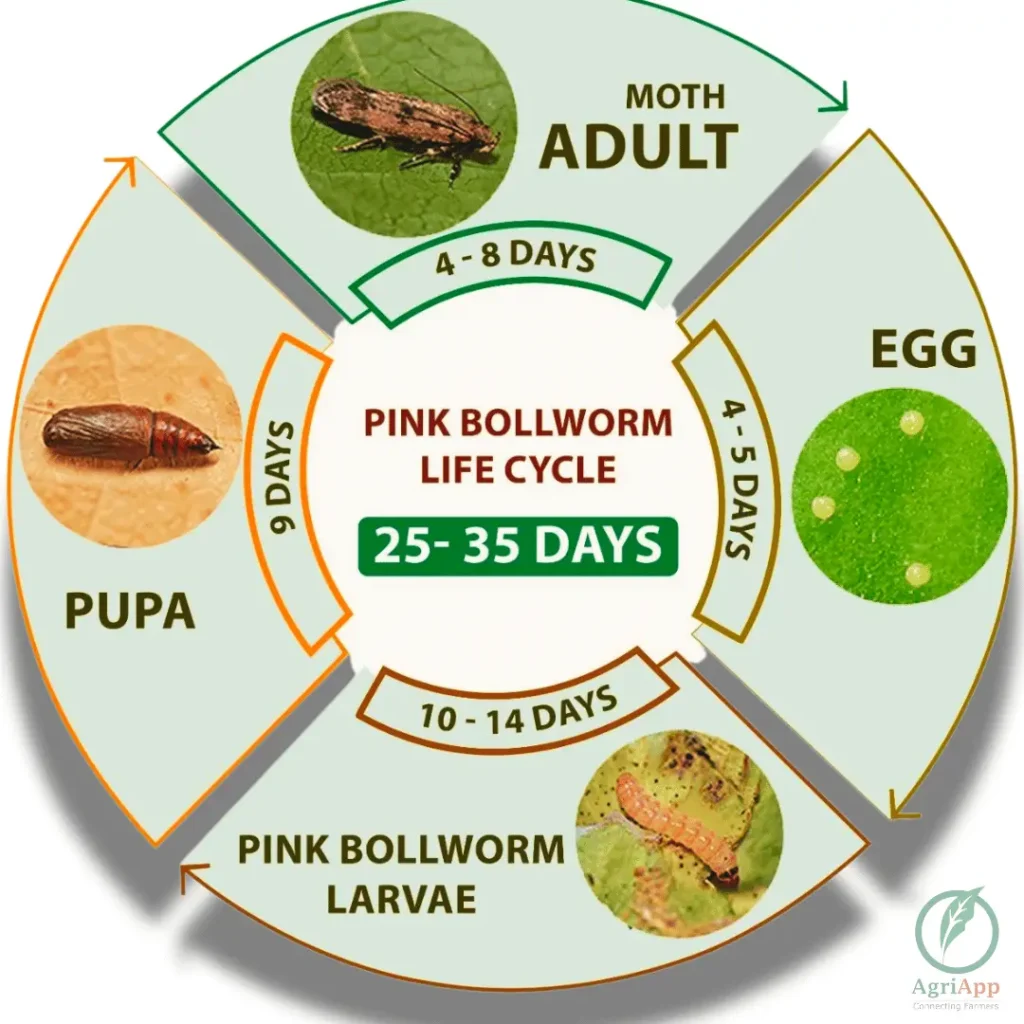Cotton is one of the most popular and highly profitable crops in the world. India is having 2nd place in the world with estimated production of 343.47 lakh bales (5.84 Million Metric Tonnes) during cotton season 2022-23 i.e. 23.83% of world cotton production. However, cotton farming faces several challenges, including pests and diseases, which spoil the crop yield and farmers’ income. Bollworms are the real headache for cotton farmers. Let’s see how to control Bollworm in different approaches.

Understanding Bollworm Infestation
Bollworms are caterpillars that feed on cotton bolls, damaging the fibers and reducing yield. The pink bollworm, in particular, is a notorious pest in cotton farming. Native to Asia, it has spread to almost all cotton-growing regions worldwide. The larvae bore into cotton bolls and consume the seeds and blossoms, making the pest difficult to detect and control.
Pink Bollworm (Pectinophora gossypiella)
Symptoms of Damage:
- Rosetted flowers
- Entry holes plugged by larvae excreta feeding inside the seed kernels
- “Double seeds” formed by cutting window holes in adjoining seeds
- Dropping off of attacked buds and immature bolls
- Discolored lint and burrowed seeds
Identification of the Pest:
Larva:
- Shows color variation: young larvae are white, and late instars are almost black, brown, or green to pale or pink
- Several dark and light alternating bands run the entire length
Adult:
- Small moth
- Forewings are brown or dull yellow-olive grey with dark spots
- Hindwing margins are deeply fringed

How to Control Pink Bollworm
Controlling pink bollworms in cotton is crucial to ensure a healthy yield and protect the crop from significant damage. The Economic Threshold Level (ETL) for pink bollworm infestation is set at 10% of the fruiting parts. This means that action to control the pink bollworm population (like applying insecticides) is only recommended if at least 10% of the cotton plant’s fruiting parts (squares, flowers, or bolls) show signs of infestation.
To manage this pest effectively, farmers should start by using pheromone traps to monitor the activity of adult moths. These traps help in early detection and timely intervention. Biological control methods include releasing the egg parasitoid Trichogrammatoidea bactrae at a rate of 1,00,000 per hectare is also an effective method after pheromone traps. This should be done weekly, timed with the incidence of the pest, to effectively reduce the bollworm population.
In addition to biological control, the use of insecticides is essential if the infestation is beyond the control. But always consult your local agricultural extension service before using any chemicals.
Dusting with Carbaryl 5%D at 20 kg/ha: This can be effective, but it’s a strong option, so use it only if the damage is high.
Spraying with Phosalone 35% EC (2000 ml/ha) or Triazophos 40% EC (2.5 liters/ha): These sprays are another option to control the bollworm population if needed.
By combining these strategies—pheromone traps, biological controls, and targeted insecticide use—farmers can significantly reduce the impact of pink bollworms on their cotton crops.
Spotted Bollworms (Earias vittella) and Spiny Bollworms (Earias insulana)
Symptoms of Damage:
- Drying and drooping of terminal shoots during the pre-flowering stage
- Shedding of squares and young bolls
- Flaring up of bracts during square and young boll formation stage
- Holes in bolls and rotting of bolls
Identification of the Pest:

Earias vittella:
Larva:
- Brownish with white streaks dorsally and pale yellow ventrally, without finger-shaped processes
Adult:
- Small buff colored
- Forewings are pea green with a wedge-shaped white band running from base to outer margin
Earias insulana:
Larva:
- Brown with dorsum showing a white median longitudinal streak
- The last two thoracic segments and all the abdominal segments have two pairs of fleshy tubercles (finger-shaped processes), one dorsal and the other lateral
Pupa:
- Brown and boat-shaped
Adult:
- Small buff colored
- Forewings are uniformly silvery green
How to Control Spotted Bollworms
Natural Methods:
Be a detective! Regularly check your cotton plants for signs of spotted bollworm damage, like holes in squares and bolls. Handpick and remove any infested squares and flowers you find. This helps prevent the worms from spreading.
Keep your field clean! Remove any alternate crops (plants that spotted bollworms also like to eat) growing near your cotton. This reduces their hiding places and food sources.
Introduce a natural enemy! A bacteria called Bacillus thuringiensis var. kurstaki (Bt) is a natural insecticide that harms spotted bollworm caterpillars. You can apply Bt as a wettable powder (WP) at a rate of 300-400 grams per acre.
Chemical Control (Last Resort):
If the spotted bollworm infestation is severe, you might need to use insecticides. However, this should be a last resort because it can harm beneficial insects in your field.
Always consult your local agricultural extension service or a trusted supplier before using any insecticide. Using too much can be harmful and ineffective. Some of the insecticides that can be used are Flubendiamide 39.35% SC: Apply 40-50 ml per acre, Chlorantraniliprole 18.5% SC: Apply 60 ml per acre, Indoxacarb 14.5% SC: Apply 200 ml per acre, Diflubenzuron 25% WP: Apply 120-140 g per acre, Fipronil 5% SC: Apply 800 ml per acre, Spinetoram 11.7% SC: Apply 168-188 ml per acre.
How to Control Spiny Bollworms

1. Keeping Things Clean and Natural:
- Be on the lookout! Regularly check your cotton plants for signs of spiny bollworm damage. This includes wilting shoots, shedding of terminal buds, and holes in squares and bolls.
- Cleanliness is key! Clear away any weeds or alternative host plants (like hibiscus or okra) growing near your cotton field. This eliminates their hiding spots and food sources.
- Attract the good guys! Beneficial insects like parasitoid wasps can help control spiny bollworm populations naturally. Consider introducing these tiny warriors to your field.
2. Organic Options (For Light Infestations):
- Early detection is crucial! Scouting for eggs or small larvae is key. Manually remove them whenever possible to stop the problem before it starts.
- Natural sprays can help! Products containing Neem Seed Kernel Extract (NSKE) or Neem oil can be effective against young spiny bollworms. Apply them as a spray following recommended rates.
- Consider a bacterial buddy! Bacillus thuringiensis (Bt) is a naturally occurring bacteria that targets caterpillars, including spiny bollworms. Use Bt following recommended application rates for your specific product.
3. Insecticides for Spiny Bollworms
Monitor closely: Scout your cotton plants regularly, especially during early bloom. Look for 10 eggs or 5 small worms per 100 plants. This is the critical point for taking action. Target the young: Spiny bollworm larvae become more resistant to insecticides as they grow. Therefore, focus on controlling eggs and young larvae.
Consider using Chlorantraniliprole, Emamectin benzoate, Flubendiamide, Esfenvalerate, Acephate 75.0% SP (Asataf from Tata), Chlorantraniliprole 9.3% ZC, Lambda-Cyhalothrin 4.6% ZC (Ampligo by Syngenta) are few insecticides you can consider.
Always consult your local agricultural extension service or a trusted supplier before using any insecticide. For Free consultation and crop advisory,
What are the Best Cotton Varieties for Drought Prone Areas? Read more here.